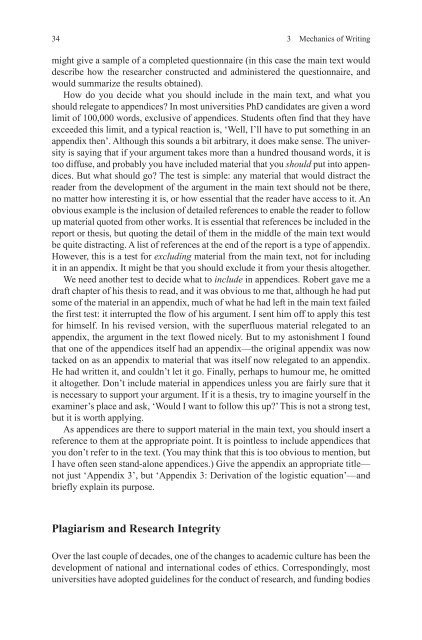How-to-Write-a-Better-Thesis
Create successful ePaper yourself
Turn your PDF publications into a flip-book with our unique Google optimized e-Paper software.
34 3 Mechanics of Writing<br />
might give a sample of a completed questionnaire (in this case the main text would<br />
describe how the researcher constructed and administered the questionnaire, and<br />
would summarize the results obtained).<br />
<strong>How</strong> do you decide what you should include in the main text, and what you<br />
should relegate <strong>to</strong> appendices? In most universities PhD candidates are given a word<br />
limit of 100,000 words, exclusive of appendices. Students often find that they have<br />
exceeded this limit, and a typical reaction is, ‘Well, I’ll have <strong>to</strong> put something in an<br />
appendix then’. Although this sounds a bit arbitrary, it does make sense. The university<br />
is saying that if your argument takes more than a hundred thousand words, it is<br />
<strong>to</strong>o diffuse, and probably you have included material that you should put in<strong>to</strong> appendices.<br />
But what should go? The test is simple: any material that would distract the<br />
reader from the development of the argument in the main text should not be there,<br />
no matter how interesting it is, or how essential that the reader have access <strong>to</strong> it. An<br />
obvious example is the inclusion of detailed references <strong>to</strong> enable the reader <strong>to</strong> follow<br />
up material quoted from other works. It is essential that references be included in the<br />
report or thesis, but quoting the detail of them in the middle of the main text would<br />
be quite distracting. A list of references at the end of the report is a type of appendix.<br />
<strong>How</strong>ever, this is a test for excluding material from the main text, not for including<br />
it in an appendix. It might be that you should exclude it from your thesis al<strong>to</strong>gether.<br />
We need another test <strong>to</strong> decide what <strong>to</strong> include in appendices. Robert gave me a<br />
draft chapter of his thesis <strong>to</strong> read, and it was obvious <strong>to</strong> me that, although he had put<br />
some of the material in an appendix, much of what he had left in the main text failed<br />
the first test: it interrupted the flow of his argument. I sent him off <strong>to</strong> apply this test<br />
for himself. In his revised version, with the superfluous material relegated <strong>to</strong> an<br />
appendix, the argument in the text flowed nicely. But <strong>to</strong> my as<strong>to</strong>nishment I found<br />
that one of the appendices itself had an appendix—the original appendix was now<br />
tacked on as an appendix <strong>to</strong> material that was itself now relegated <strong>to</strong> an appendix.<br />
He had written it, and couldn’t let it go. Finally, perhaps <strong>to</strong> humour me, he omitted<br />
it al<strong>to</strong>gether. Don’t include material in appendices unless you are fairly sure that it<br />
is necessary <strong>to</strong> support your argument. If it is a thesis, try <strong>to</strong> imagine yourself in the<br />
examiner’s place and ask, ‘Would I want <strong>to</strong> follow this up?’ This is not a strong test,<br />
but it is worth applying.<br />
As appendices are there <strong>to</strong> support material in the main text, you should insert a<br />
reference <strong>to</strong> them at the appropriate point. It is pointless <strong>to</strong> include appendices that<br />
you don’t refer <strong>to</strong> in the text. (You may think that this is <strong>to</strong>o obvious <strong>to</strong> mention, but<br />
I have often seen stand-alone appendices.) Give the appendix an appropriate title—<br />
not just ‘Appendix 3’, but ‘Appendix 3: Derivation of the logistic equation’—and<br />
briefly explain its purpose.<br />
Plagiarism and Research Integrity<br />
Over the last couple of decades, one of the changes <strong>to</strong> academic culture has been the<br />
development of national and international codes of ethics. Correspondingly, most<br />
universities have adopted guidelines for the conduct of research, and funding bodies














![[Lonely Planet] Sri Lanka](https://img.yumpu.com/59845622/1/169x260/lonely-planet-sri-lanka.jpg?quality=85)


